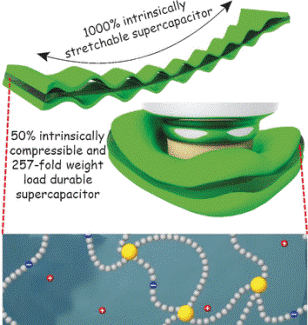Jul 4 2017
Wearable and flexible electronics mandate equivalently wearable and flexible power sources.
Chinese Researchers have now developed an exceptionally compressible and stretchable polyelectrolyte which when integrated with carbon nanotube composite paper electrodes results in a supercapacitor. It has the ability to be stretched to nearly 1000% in length and compressed to about 50% of its thickness without reduction in capacity but gaining more capacity. The outcomes of the research have been reported in the journal Angewandte Chemie.
 Credit: Wiley
Credit: Wiley
The functions of supercapacitors fall between that of batteries (i.e. normal energy-storing devices) and normal capacitors that discharge and take up electric energy in a rapid way but do not have the ability to store much energy. The potential of the supercapacitors to charge and discharge vast amounts of electric energy in a shorter period of time enables them to be ideally applied as power buffers in wind turbines, for regenerative braking, and increasingly in consumer electronics (e.g. digital cameras and laptop computers). In order to render supercapacitors suitable for next-generation electronic requirements such as paper electronics and wearables, Chunyi Zhi at the City University of Hong Kong and his team are working on the methods for equipping the supercapacitors with mechanical flexibility. In order to achieve this, they developed an innovative electrolyte material, namely, a polyelectrolyte with a stretchability of over 10 times its original length and which can be compressed to nearly half its thickness without any drop in full functionality and without cracking, breakage or other damage to the material.
Polyvinyl alcohol gel-based electrolytes—which are chiefly used in supercapacitors and are mechanically more flexible—are synthesized by using elastic components such as fibers or rubber. The innovative electrolyte synthesized by Zhi and his team is based on a different concept—it is formed of a polyacrylamide (PAM) hydrogel that is reinforced with vinyl-functionalized silica nanoparticles (VSPNs). The cross-links in the VSPNs make the material highly stretchable. Moreover, the material is highly conductive due to the characteristics of the polyelectrolyte that expands in water and retains and transports ions.
VSNPs cross-linkers serve as stress buffers to dissipate energy and homogenize the PAM network. These synergistic effects are responsible for the intrinsic super-stretchability and compressibility of our supercapacitor.
Chunyi Zhi, The City University of Hong Kong
The Researchers fabricated a functional supercapacitor using the polyelectrolyte by directly paving two similar carbon nanotube composite paper electrodes on either side of the pre-stretched polyelectrolyte film. During discharge, a wavy, accordion-like structure with astonishing electrochemical properties was synthesized. “The electrochemical performance gets enhanced with the increase of strain,” discovered the Researchers. Furthermore, the strain was immense and the supercapacitor was able to withstand a stretch of nearly 1000% and a compression of nearly 50% with even greater or same potential. Such a high flexibility renders the polyelectrolyte highly enticing for innovative advancements such as wearable electronics.